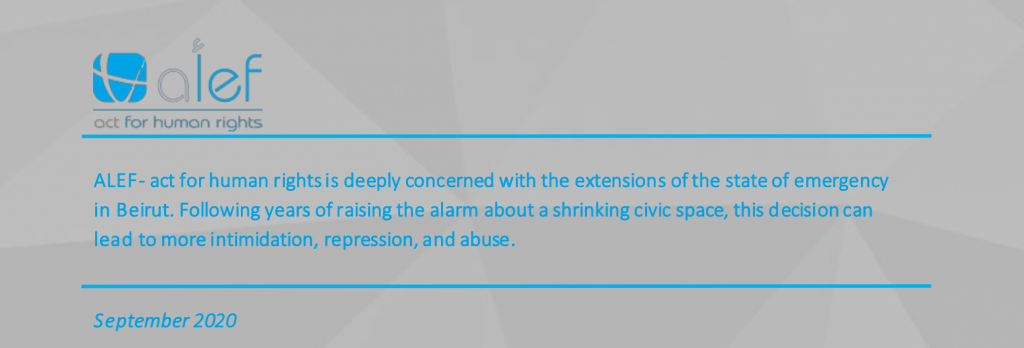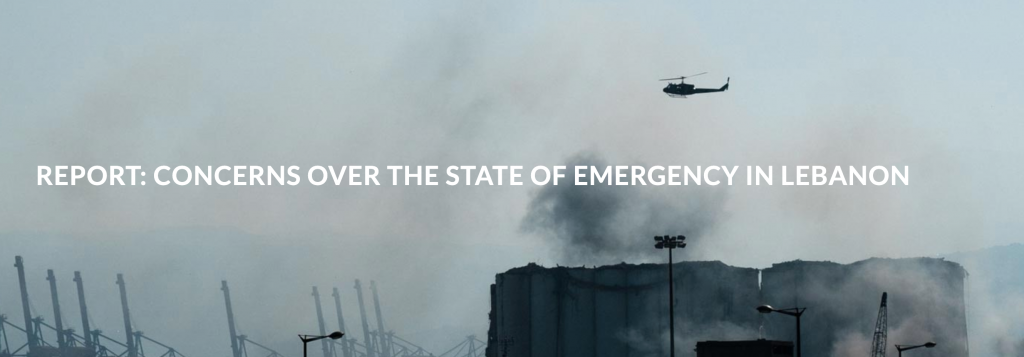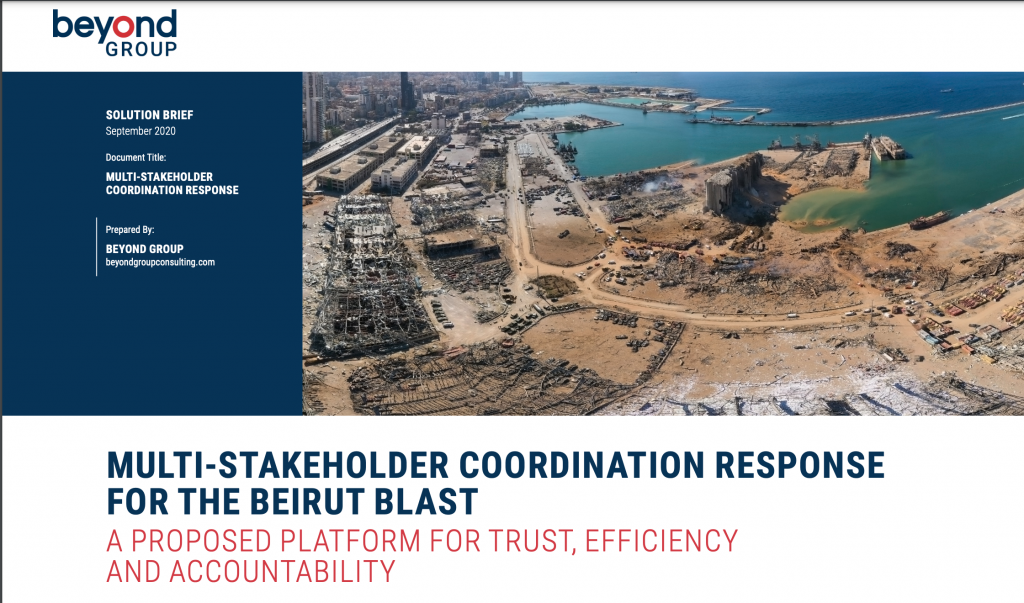Disaster Management
Declaration of State of Emergency
On August 5, 2020, in response to the blast, the Council of Ministers declared by decree 6792 a state of emergency, giving full control to the Lebanese Armed Forces. The state of emergency was limited to the Governorate of Beirut from 5 August 2020, until 18 August, 2020. It was extended until September 18, 2020, and extended one last time again until 31 December 2020. This Decree remained unpublished, which created confusion as to what to expect and for how long.
Declaring a State of Emergency is allowed in Lebanon under Legislative Decree No. 52. It grants the Government the power to declare a State of Emergency in “all or part of the Lebanese territory when the country is exposed to an imminent danger resulting from a foreign war, armed revolution, actions or turmoil threatening public order and security, or in the event of incidents characterized as a disaster.”
Below are two reports on the declared State of Emergency

In this report ALEF- act for human rights is deeply concerned with the extensions of the state of emergency in Beirut. Following years of raising the alarm about a shrinking civic space, this decision can
lead to more intimidation, repression, and abuse.

The report contains the initial assessment of the declared State of Emergency in August 2020 in terms of its legal shortcomings and its potential threat to both human rights and human security in Lebanon.
The Response
According to the “National progress report on the implementation of the Hyogo Framework for Action (2013-2015)” a National Disaster Response Plan (NRDP) was developed by the Committee responsible for emergency plans composed of representatives from the Ministry of National Defense, the General Directorate of Internal Security Forces, the Ministry of Interior and Municipalities, the General Customs Directorate, the General Directorate of Public Security, the General Directorate of State Security, the General Directorate of Civil Defense and the Beirut Fire Brigade. The NRDP defines the roles and responsibilities of the main disaster response agencies in preparedness, response, and recovery.
However, based on anecdotal evidence, the Committee did not provide any strategic direction to security actors, including the ISF, in the aftermath of the Beirut explosion. A Colonel at the LAF reported that the National Coordination Committee was actually “in shock after the blast and was not ready to operate promptly”.
In the blast’s aftermath, most donors expressed their distrust in state institutions and turned instead to the United Nations, the World Bank, and the European Union to disburse international donations. Local NGOs and the LAF were also relied upon to provide services and humanitarian aid.

The Civil Defense volunteers were the first responders to arrive
at the blast site after the explosion. They were in charge of the
search and rescue operation. They transported nearly
310 wounded to hospitals, extinguished 30 fires,
carried out 145 search and rescue missions,
and surveyed around 173 sites to search for casualties.
The volunteers of the Civil Defense risked their
own lives to save others despite lacking rights
for not being considered as staff within the organisation
and severely lacking resources and equipment.
The LAF in the first days following the blast was also
busy preserving the crime scene and protecting
the city in addition to assisting in the search and
rescue operations and evacuating the injured.
The local response following the blast was immediate and spontaneous. It involved public and private actors, associated initiatives, NGOs, and young people from all over the country to provide support, principally to remove the rubble, clean, assess the damage, and provide temporary shelter, accommodation and food. Several NGOs also started reconstruction work.
When the Lebanese authorities declared the rescue phase over on August 9, the Army requested a more important role on the ground. The LAF then established a Forward Emergency Room (FER)to coordinate the humanitarian response on the ground. The FER‘s mandate included mapping needs and support, coordinating efforts, and supporting NGOs and volunteers. Effectively, the LAF was coordinating the humanitarian response in addition to safeguarding the city and its inhabitants. This mandate was beyond what was outlined in the State of Emergency Decree issued on August 7, 2020, and beyond the powers conferred on the army in Legislative Decree No. 52/67 regulating States of Emergency. The decree did not mention the humanitarian aspect.
The FER worked closely with the Lebanese Red Cross and representatives from several ministries, governorates and municipalities and a team of consultants and volunteers to plan, organize, and communicate with the different NGOs and the victims. It collaborated and coordinated with over 60 NGOs. The NGOs willing to work on the ground had to ask “permission” to do so. According to Caritas and the Lebanese Red Cross, this collaboration and coordination were important and effective. However, some NGOs, such as CLDH, saw this measure as an interference in their work.
The role of the FER was mainly to coordinate food distribution (a total of 343,168 food parcels), distribute the medical aid to specific institutions and hospitals and to conduct house damage assessments. In coordination with the Ministry of Public Health and the Ministry of Defense, army units distributed 50% of the humanitarian aid that reached Lebanon. While the embassies of donor countries, several non-governmental organizations, and the High Relief Commission distributed the rest.
The Governmental institutions, including the Ministry of Health, the Ministry of Social Affairs, the Ministry of Defense, the Higher Council for Relief, and the Beirut Municipality, responded sporadically to the needs, which included food distribution, medical aid, children-focused activities, restoration of disabled people’s homes, etc.
The Response in the aftermath of the blast lacked strategic planning.
The lack of strategic planning made the response chaotic, and, at times, inefficient. The lack of experience in a humanitarian crisis made the FER change its modus operandi several times to adapt to the situation. For example, at first, the food rations were stored in tents in the affected areas to come and pick up. When very few people showed up (probably because they did not want to appear to be begging for food on top of their distress), the FER started sending volunteers door to door to distribute the food.
In the initial days after the blast, the Higher Council for Relief was in charge of assessing the damage; the landlords and the tenants had to provide several documents (registration, deeds, ID’s) to claim compensation. These documents were costly and needed a notary’s signature. When the FER took over the housing assessment, they no longer requested these documents.
Additionally, several stakeholders were evaluating the damage and assessing the needs. This duplication added distress on the survivors – many were not comfortable opening their homes and sharing information with all those involved in the response. Some felt that the right to their privacy was violated. Moreover, emergency aid was delivered several times to the same persons or persons not in real need.
In addition, the lack of information or contradicting information added to the frustration, adding to the general mistrust of governmental sources. The rapid spreading of false, dubious, and misleading information was overwhelming.
The lack of coordination between all state institutions has gravely affected the efficiency in delivering aid. For instance, the response would have been far more efficient with a better reach for all persons had the LAF coordinated with the state security apparatus from the beginning of the response. Likewise, the Ministry of Health and Ministry of Social Affairs did not set a joint strategy or an action plan to answer to the needs post-disaster. This lack of planning reveals a dire need for a body that coordinates the government’s work and an urgent need to digitalize the government to facilitate access to information and data sharing. The absence of a disaster mitigation plan rendered the ground response uncoordinated and left many affected persons without shelter assistance and protection services.
Generally, according to victims, the aid response seemed uncoordinated as well, and poorly targeted.
It is certain that such disasters inevitably create chaos. However, the response from the several stakeholders involved demonstrated a lack of preparedness. It stressed even more strongly how crucial it is for Lebanon to establish or empower an institution that would lead disaster risk reduction and disaster management.

مرفأ بيروت
للهيئة الوطنية لحقوق الانسان
Monitoring the Human Rights Violations in the
Response to the Beirut Blast
by the National Human Rights Commission
Disasters are typically recurring events with four phases: Mitigation, Preparedness, Response, and Recovery.
With the Beirut Blast emergency, Lebanon found itself in Phase 3 “Response” immediately. The planning and preparedness phase occurred in parallel when they were supposed to have been in place before the disaster. This explains the shortcoming of the response as stated above.
Surprisingly, Lebanon was not behind in terms of disaster management and preparedness. It had adhered to the Hyogo Framework for Action and was in the process of implementing it since 2005. The Hyogo Framework for Action is the blueprint for implementing disaster risk reduction, adopted by the United Nations. It aims to build the resilience of nations and communities to disasters, by substantively reducing the losses in lives and the communities and countries’ social, economic, and environmental assets. It is centred on strategic goals and five priorities which are: 1) Making disaster risk reduction (DRR) a priority 2) Knowing the risks and taking action, 3) Building understanding and awareness, 4) Reducing the risk, 5) Being prepared and ready to act.
According to the Lebanese National Progress report on the implementation of the Hyogo Framework for Action (2013 – 2015): Disaster Risk Reduction was considered a priority at the national, sectoral, and local levels. A National Response Plan for all types of disasters was developed; it includes the roles and responsibilities of major agencies in preparedness, response, and recovery to major disasters, and it established a National Operations Room. At the sectoral level, several Ministries and key agencies integrated disaster risk considerations into sustainable development, including the Ministry of Education, Ministry of Social Affairs, Ministry of Agriculture, and the airports. The Lebanese Army Command at the Ministry of Defense has also integrated DRR.
At the institutional level, through decision 41/2013 in February 2013, the Prime Minister established the National Coordination Committee under the leadership of the Secretary of the Supreme Council for Defense and the membership of the major relief commission departments and General Directors of concerned relevant ministries – including the DRM Unit.
And yet, when the disaster occurred, the National Response Plan was put aside, a new FER was established, and the Disaster Management Unit was not activated. The State of Emergency was declared and the Army took the lead. The Army who had already been trained in disaster management applied in its response to the Beirut blast the Hyogo Framework which is focused on a proactive approach instead of the “people centered approach” elaborated in the Sendai Framework that replaced the Hyogo framework in 2015. Indeed, instead of focusing on the actual peoples’ needs the army established general criteria to distribute aids and applied them to all without considering gender, age and disabilities.
The Sendai Framework on Disaster Risk Reduction (2015-2030) is an ambitious agreement that pursues the following goal: “Prevent new and reduce existing disaster risk through the implementation of integrated and inclusive economic, structural, legal, social, health, cultural, educational, environmental, technological, political and institutional measures that prevent and reduce hazard exposure and vulnerability to disaster, increase preparedness for response and recovery, and thus strengthen resilience.”
The Framework acknowledges that the strong commitment and involvement of the Government in every country is fundamental. In addition to natural threats covered by the Hyogo Framework for Action, the Sendai Framework covers technological threats. These include chemical/industrial hazards, and radiological, nuclear, biological, among others.
Lebanon would benefit from reviewing its current National Response Plan and adapting it to the Sendai Framework.
